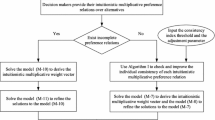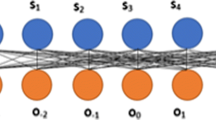Abstract
Hesitant multiplicative preference relations (HMPRs) are utilized to describe situations where a decision maker gives several possible values by Saaty’s 1-9 scale in pairwise comparison. For further applications of HMPRs, this paper develops two priority methods based on data envelopment analysis (DEA) for group decision making. These methods include self-weight prioritization and the cross-weight prioritization, which are similar to the self-evaluation efficiency and the cross-evaluation efficiency in DEA theory, respectively. We prove that both of them can generate true priority weights for consistent HMPRs. The mechanisms of these proposed methods are illustrated with numerical examples. Also, comparisons with other methods are performed to show the advantages of the proposed methods.

Similar content being viewed by others
References
Charnes A, Cooper WW, Rhodes E (1978) Measuring the efficiency of decision making units. Eur J Oper Res 2:429–444
Chiclana F, Herrera-Viedma E, Alonso S, Herrera F (2009) Cardinal consistency of reciprocal preference relations: a characterization of multiplicative transitivity. IEEE Trans Fuzzy Syst 17:14–23
Dong YC, Chen X, Herrera F (2015) Minimizing adjusted simple terms in the consensus reaching process with hesitant linguistic assessments in group decision making. Inf Sci 297:95–117
Doyle J, Green R (1994) Efficiency and cross-efficiency in DEA: derivations, meanings and uses. J Oper Res Soc 45:567–578
Dubois DJ (1980) Fuzzy sets and systems, theory and applications. Academic Press, Orlando
Fan ZP, Ma J, Jiang YP, Sun YH, Ma L (2006) A goal programming approach to group decision making based on multiplicative preference relations and fuzzy preference relations. Eur J Oper Res 174:311–321
Gong ZW (2008) Least-square method to priority of the fuzzy preference relations with incomplete information. Int J Approx Reason 47:258–264
Herrera F, Herrera-Viedma E, Verdegay JL (1996) A model of consensus in group decision making under linguistic assessments. Fuzzy Sets Syst 78:73–87
Hosseinian SS, Navidi H, Hajfathaliha A (2012) A new linear programming method for weights generation and group decision making in the analytic hierarchy process. Group Decis Negot 21:233–254
Kou G, Lin CS (2014) A cosine maximization method for the priority vector derivation in AHP. Eur J Oper Res 235:225–232
Li KW, Wang ZJ, Tong XY (2016) Acceptability analysis and priority weight elicitation for interval multiplicative comparison matrices. Eur J Oper Res 250:628–638
Liang L, Wu J, Cook WD, Zhu J (2008) Alternative secondary goals in DEA cross-efficiency evaluation. Int J Prod Econ 113:1025–1030
Liao HC, Xu ZS (2014) Priorities of intuitionistic fuzzy preference relation based on multiplicative consistency. IEEE Trans Fuzzy Syst 22:1669–1681
Lin Y, Wang YM, Chen SQ (2016) Hesitant fuzzy multiattribute matching decision making based on regret theory with uncertain weights. Int J Fuzzy Syst. doi:10.1007/s40815-016-0213-x
Lin Y, Wang YM, Chen SQ (2017) Multistage decision making based on prioritization of hesitant multiplicative preference relations. J Intell Fuzzy Syst 32:691–701
Lipovetsky S, Conklin WM (2002) Robust estimation of priorities in the AHP. Eur J Oper Res Soc 137:110–122
Liu PD, Shi L (2015) The generalized hybrid weighted average operator based on interval neutrosophic hesitant set and its application to multiple attribute decision making. Neural Comput Appl 26(2):457–471
Orlovsky SA (1978) Decision-making with a fuzzy preference relation. Fuzzy Sets Syst 1:155–167
Ramanathan R (2006) Data envelopment analysis for weight derivation and aggregation in the analytic hierarchy process. Comput Oper Res 33:1289–1307
Rodríguez RM, Martínez L, Torra V, Xu ZS, Herrera F (2014) Hesitant fuzzy sets: state of the art and future directions. Int J Intell Syst 29:495–524
Rodríguez RM, Bedregal B et al (2015) A position and perspective analysis of hesitant fuzzy sets on information fusion in decision making. Towards high quality progress. Inf Fusion 29:89–97
Saaty TL (1980) The analysis hierarchy process. McGraw-Hill Company, New York
Saaty TL, Vargas LG (1984) Comparison of eigenvalue, logarithmic least squares and least squares methods in estimating ratios. Math Model 5:309–324
Saaty TL, Vargas LG (1987) Uncertainty and rank order in the analytic hierarchy process. Eur J Oper Res 32:107–117
Sexton TR, Silkman RH, Hogan AJ (1986) Data envelopment analysis: critique and extensions. New Dir Eval 32:73–105
Sinuany-Stern Z, Mehrez A, Hadad Y (2006) An AHP/DEA methodology for ranking decision making units. Int Trans Oper Res 7:109–124
Tanino T (1984) Fuzzy preference orderings in group decision making. Fuzzy Sets Syst 12:117–131
Tanino T (1988) Fuzzy preference relations in group decision making. In: Kacprzyk J, Roubens M (eds) Non-conventional preference relations in decision making. Springer, Berlin
Torra V (2010) Hesitant fuzzy sets. Int J Intell Syst 25:529–539
Torra V, Narukawa Y (2009) On hesitant fuzzy sets and decision. In: The 18th IEEE international conference on fuzzy systems. Jeju Island, Korea, pp 1378–1382
Wang YM, Chin KS (2009) A new data envelopment analysis method for priority determination and group decision making in the analytic hierarchy process. Eur J Oper Res 195:239–250
Wang YM, Chin KS (2010) A neutral DEA model for cross-efficiency evaluation and its extension. Expert Syst Appl 37:3666–3675
Wang ZJ, Li KW (2015) A multi-step goal programming approach for group decision making with incomplete interval additive reciprocal comparison matrices. Eur J Oper Res 242(3):890–900
Wang ZJ, Li KW (2016) Group decision making with incomplete intuitionistic preference relations based on quadratic programming models. Comput Ind Eng 93:162–170
Wang H, Xu ZS (2016) Multi-groups decision making using intuitionistic-valued hesitant fuzzy information. Int J Comput Intell Sys 9:468–482
Wang YM, Yang JB, Xu DL (2005) A two-stage logarithmic goal programming method for generating weights from interval comparison matrices. Fuzzy Sets Syst 152:475–498
Wang YM, Chin KS, Poon GKK (2008) A data envelopment analysis method with assurance region for weight generation in the analytic hierarchy process. Decis Support Syst 45:913–921
Wang YM, Luo Y, Xu YS (2013) Cross-weight evaluation for pairwise comparison matrices. Group Decis Negot 22:483–497
Wu DD (2009) Performance evaluation: an integrated method using data envelopment analysis and fuzzy preference relations. Eur J Oper Res 194:227–235
Wu Z, Xu J (2012) A consistency and consensus based decision support model for group decision making with multiplicative preference relations. Decis Support Syst 52:757–767
Wu J, Liu Y, Liang C (2015) A consensus- and harmony- based feedback mechanism for multiple attribute group decision making with correlated intuitionistic fuzzy sets. Int Trans Oper Res 22:1033–1054
Wu J, Chu J, Sun J, Zhu Q (2015) DEA cross-efficiency evaluation based on Pareto improvement. Eur J Oper Res 248:571–579
Xia MM, Xu ZS (2013) Managing hesitant information in GDM problems under fuzzy and multiplicative preference relations. Int J Uncertain Fuzziness 21:865–897
Xu ZS (2007) Intuitionistic preference relations and their application in group decision making. Inf Sci 177:2363–2379
Xu ZS, Cai X (2014) Deriving weights from interval multiplicative preference relations in group decision making. Group Decis Negot 23:695–713
Xu ZS, Chen J (2008) Some models for deriving the priority weights from interval fuzzy preference relations. Eur J Oper Res 184:266–280
Xu ZS, Da QL (2003) An overview of operators for aggregating information. Int J Intell Syst 18:953–969
Xu Y, Chen L, Li KW, Wang H (2015) A Chi square method for priority derivation in group decision making with incomplete reciprocal preference relations. Inf Sci 306:166–179
Zadeh LA (1965) Information and control. Fuzzy Sets 8:338–353
Zhang Z, Guo CH (2016) Fusion of heterogeneous incomplete hesitant preference relations in group decision making. Int J Comput Intell Syst 9:245–262
Zhang XL, Xu ZS (2014) The TODIM analysis approach based on novel measured functions under hesitant fuzzy environment. Knowl-Based Syst 61:48–58
Zhang ZM, Wu C, Zhang Z, Wu C (2014) Deriving the priority weights from hesitant multiplicative preference relations in group decision making. Appl Soft Comput 25:107–117
Zhu B, Xu ZS, Xu JP (2014) Deriving a ranking from hesitant fuzzy preference relations under group decision making. IEEE Trans Cybern 44(8):1328–1337
Acknowledgements
The authors thank Prof. Shengqun Chen for his helpful discussions and comments and also thank the anonymous referees and the editor for their insightful suggestions which lead to the present version of this paper. The work was partly supported by the National Natural Science Foundation of China (Grant No. 71371053), the Humanities and Social Sciences Foundation of Ministry of Education of China (Grant No. 16YJC630008), the Fujian Provincial Young Teacher Educational Research Foundation (Grant No. JAS160132) and the Teaching Reform Foundation of Fujian Normal University of China (Grant No. I201603023).
Author information
Authors and Affiliations
Corresponding author
Ethics declarations
Conflict of interest
The authors declare that they have no financial and personal relationships with other people or organizations that can inappropriately influence their work, and there is no professional or other personal interest of any nature or kind in any product, service and/or company that could be construed as influencing the position presented in, or the review of, the manuscript entitled, “Prioritization of hesitant multiplicative preference relations based on data envelopment analysis for group decision making.”
Rights and permissions
About this article
Cite this article
Lin, Y., Wang, YM. Prioritization of hesitant multiplicative preference relations based on data envelopment analysis for group decision making. Neural Comput & Applic 31, 437–447 (2019). https://doi.org/10.1007/s00521-017-3075-8
Received:
Accepted:
Published:
Issue Date:
DOI: https://doi.org/10.1007/s00521-017-3075-8




